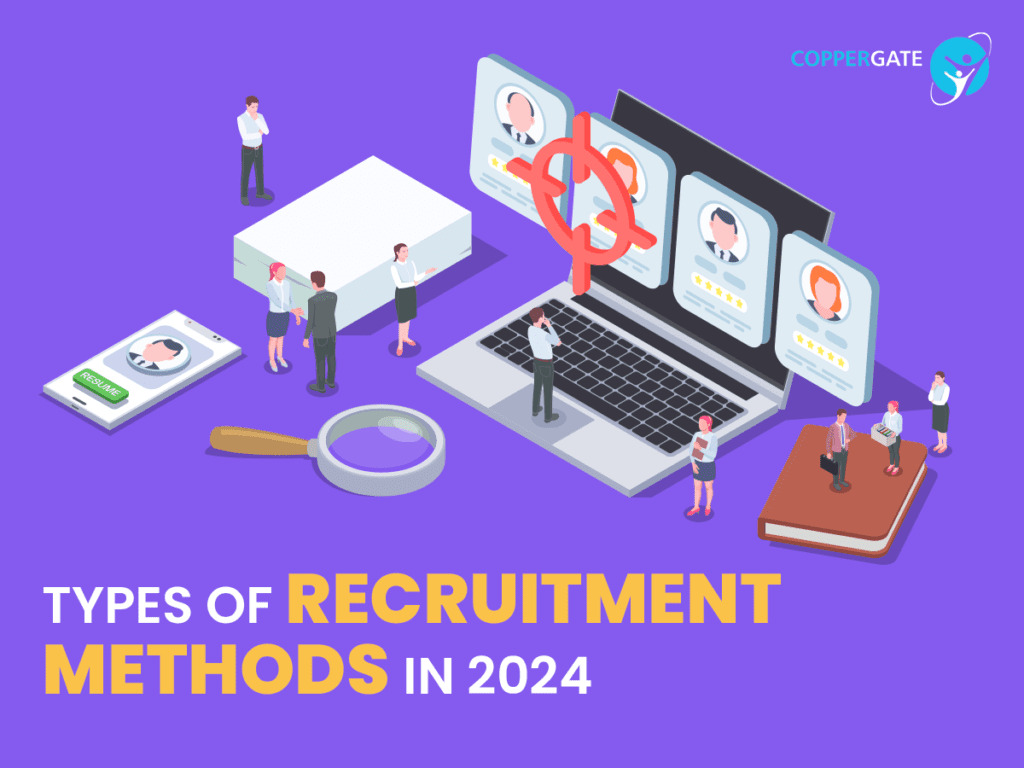In the ever-evolving landscape of talent acquisition, staying ahead of the competition requires a keen understanding of the multitude of recruitment methods available.
As we navigate through 2024, the realm of recruitment continues to transform, demanding adaptability and vision from hiring professionals. From traditional strategies to cutting-edge approaches, the spectrum of recruitment methods encompasses various avenues to attract, engage, and retain top-tier talent.
Understanding the dynamics of recruitment is crucial in today’s competitive market. This article answers the question- What are the various sources of recruitment?
This guide delves into the 14 types of recruitment methods that are essential for organizations aiming to build robust teams and drive sustainable growth. From external recruitment methods to the nuances of internal talent sourcing, this guide provides a comprehensive overview of the diverse strategies shaping the recruitment landscape in 2024.
Before delving into the specific recruitment methods, it’s crucial to differentiate between internal and external recruitment.
Internal Vs External Recruitment:
Internal Recruitment:
Internal recruitment involves filling job vacancies from within the existing workforce. This method taps into the talent pool already familiar with the company culture, processes, and goals. It promotes employee retention, boosts morale, and encourages career progression.
Types of Internal Recruitment Methods:
Promotions:
Promotions involve elevating current employees to higher positions within the organization. It rewards employee loyalty, motivates performance, and fosters a culture of growth and development.
Transfers:
Transfers entail moving employees from one department or location to another. This method allows organizations to utilize existing talent effectively, address skill gaps, and provide employees with diverse experiences.
Internal Job Postings:
Internal job postings involve advertising job vacancies within the organization to existing employees. It encourages career advancement, promotes transparency, and facilitates internal mobility.
Employee Referrals:
Employee referral programs encourage existing employees to recommend suitable candidates for job openings. This method leverages employees’ networks, enhances cultural fit, and streamlines the recruitment process.
External Recruitment:
External recruitment encompasses sourcing candidates from outside the organization. It broadens the talent pool and injects fresh perspectives into the company. External recruitment methods leverage various channels such as job boards, social media, recruitment agencies, career fairs, campus placements, and professional networks to attract potential candidates.
14 Types of External Recruitment Methods:
Job Boards:
Online job boards like Monster, Indeed, and Glassdoor are popular platforms for posting job vacancies. These platforms allow companies to reach a wide audience and attract candidates actively seeking opportunities. Posting vacancies on these platforms increases visibility and allows for easy application management.
Social Media:
Social networking sites such as Facebook, Twitter, LinkedIn and Instagram are not only platforms for personal interaction but also potent tools for recruitment. Companies utilize social media to showcase their culture, engage with potential candidates, and advertise job openings. In today’s digital age, this is one of the best sources of recruitment.
Recruitment Agencies:
Partnering with recruitment agencies can streamline the hiring process by leveraging their expertise in sourcing, screening, and presenting qualified candidates. These agencies often have extensive networks and can target specialized skill sets. Employing the services of recruitment agencies can save companies time and resources.
Career Fairs:
Career fairs provide a platform for companies to interact with job seekers face-to-face. These events allow organizations to showcase their brand, culture, and career opportunities while enabling candidates to learn more about the company and its offerings.
Campus Placements:
Targeting universities and colleges for talent acquisition is a strategic approach, especially for entry-level or graduate positions. Partnering with universities and colleges to recruit fresh graduates through campus placement programs enables organizations to identify and nurture young talent.
Professional Networks:
Platforms like Meetup, industry forums, and professional associations facilitate networking opportunities for recruiters and job seekers. Engaging with professional associations and industry groups can yield access to niche talent pools. These associations often have job boards, networking events, and member directories tailored to specific sectors or professions.
Internship Programs:
Internship programs offer organizations the opportunity to assess and groom young talent while providing students with valuable hands-on experience. Converting interns into full-time employees can be a strategic long-term investment in talent acquisition.
Headhunting:
Headhunting involves proactively seeking out and recruiting highly qualified candidates, often from competitors or specific industries. This method requires strategic targeting and personalized approaches to attract top talent. For senior-level or specialized positions, headhunting or executive search firms can be instrumental in identifying and attracting top-tier talent.
Freelance Platforms:
Freelance platforms like Upwork and Freelancer offer a flexible approach to recruitment, allowing companies to hire freelancers for short-term projects or specialized tasks. This method provides access to a global talent pool with diverse skills and expertise.
Consultancy Services:
Consulting firms offer recruitment services as part of their repertoire, assisting organizations in identifying, assessing, and hiring candidates for specific roles or projects. These firms provide tailored solutions based on the company’s needs and industry requirements.
Job Advertisements:
Traditional methods such as newspaper advertisements, industry publications, and trade journals are still viable channels for recruitment. These ads reach a targeted audience within a specific geographic or industry niche.
Networking Events:
Attending industry conferences, seminars, and networking events provides opportunities for recruiters to connect with potential candidates in a professional setting. Building relationships with professionals in the field can lead to valuable referrals and future hires.
Online Communities:
Engaging with online communities, forums, and niche platforms relevant to the industry or job role can uncover hidden talent pools. Participating in discussions, sharing insights, and offering value to these communities can attract passive candidates.
Company Website:
Maintaining an updated careers section on the company website is essential for attracting candidates who are already interested in the organization. Providing detailed job descriptions, employee testimonials, and information about the company culture enhances the recruitment process.
Conclusion:
In the dynamic landscape of recruitment, leveraging a diverse array of methods is crucial for sourcing top talent. Whether through internal promotions or external channels, finding the right candidates requires strategic planning, effective communication, and a deep understanding of the organization’s needs. By exploring and embracing various recruitment methods, businesses can stay ahead in the competition for talent acquisition.
Remember- Whether it’s leveraging technology, networking with professionals, or fostering internal referrals, the key lies in adapting to evolving trends and aligning recruitment strategies with organizational goals.
This article aims to provide readers with a comprehensive understanding of recruitment methods, catering to HR professionals, hiring managers, and organizational leaders seeking to enhance their talent acquisition strategies in 2024.




